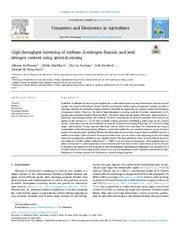Prikaz osnovnih podataka o dokumentu
High-throughput screening of soybean di-nitrogen fixation and seed nitrogen content using spectral sensing
| dc.creator | Vollmann, Johann | |
| dc.creator | Rischbeck, Pablo | |
| dc.creator | Pachner, Martin | |
| dc.creator | Đorđević, Vuk | |
| dc.creator | Manschadi, Ahmad | |
| dc.date.accessioned | 2022-08-02T10:53:03Z | |
| dc.date.available | 2022-08-02T10:53:03Z | |
| dc.date.issued | 2022 | |
| dc.identifier.issn | 0168-1699 | |
| dc.identifier.uri | http://fiver.ifvcns.rs/handle/123456789/2963 | |
| dc.description.abstract | Symbiotic di-nitrogen fixation of grain legumes has a substantial impact on crop performance, harvest product quality, and nitrogen (N) balance of crop rotations, particularly under organic management regimes. In soybean breeding, selection for increased nitrogen fixation is desirable for improving seed protein content and N balance of cropping systems. However, the lack of high-throughput screening methods for direct measurement of N2 fixation rates prohibits practical breeding efforts. Therefore, hyperspectral canopy reflectance measurement as a field-based phenotyping method was evaluated in three environments for indirect estimation of N fixation and uptake of soil nitrogen in a set of early maturity soybean genotypes exhibiting a wide range in seed protein content. Reflectance spectra were collected in repeated measurements during flowering and early seed filling stages. Subsequently, various spectral reflectance indices (SRIs) were calculated for characterizing nitrogen accumulation of individual genotypes. Moreover, prediction models for seed protein content as an end-of-season target trait were developed utilizing full spectral information in partial-least-square regression (PLSR) models. A number of N-related SRIs calculated from spectral reflectance data recorded at the beginning of the seed filling stage were significantly correlated to seed protein content. The best prediction of seed protein content, however, was achieved in PLSR models (validation R2 = 0.805 across all three environments). Environments lower in initial soil mineral N content appeared as more favorable selection sites in terms of prediction accuracy, because N fixation is not masked by soil N uptake in such environments. Hyperspectral reflectance data proved to be a valuable method for determining genetic variation in crop N accumulation, which might be implemented in highthroughput screening protocols for N fixation in plant breeding programs. | sr |
| dc.language.iso | en | sr |
| dc.publisher | Elsevier | sr |
| dc.relation | info:eu-repo/grantAgreement/EC/H2020/771367/EU// | sr |
| dc.relation | BOKU project “Phenotyping Across Experimental Scales” (project no. IA 13460) | sr |
| dc.rights | openAccess | sr |
| dc.rights.uri | https://creativecommons.org/licenses/by/4.0/ | |
| dc.source | Computers and Electronics in Agriculture | sr |
| dc.subject | soybean | sr |
| dc.subject | phenotyping | sr |
| dc.subject | di-nitrogen fixation | sr |
| dc.subject | Seed protein content | sr |
| dc.subject | Spectral reflectance index | sr |
| dc.title | High-throughput screening of soybean di-nitrogen fixation and seed nitrogen content using spectral sensing | sr |
| dc.type | article | sr |
| dc.rights.license | BY | sr |
| dc.citation.rank | aM21 | |
| dc.citation.spage | 107169 | |
| dc.citation.volume | 199 | |
| dc.identifier.doi | 10.1016/j.compag.2022.107169 | |
| dc.identifier.fulltext | http://fiver.ifvcns.rs/bitstream/id/8297/vollmann.pdf | |
| dc.identifier.scopus | 2-s2.0-85133259073 | |
| dc.type.version | publishedVersion | sr |


